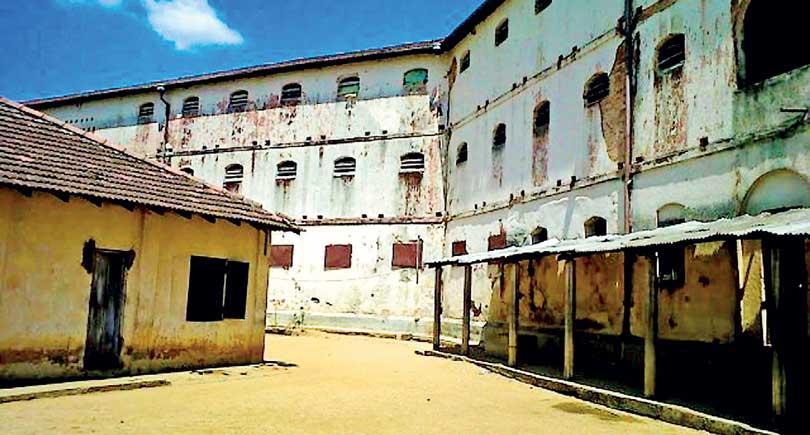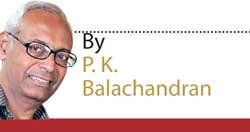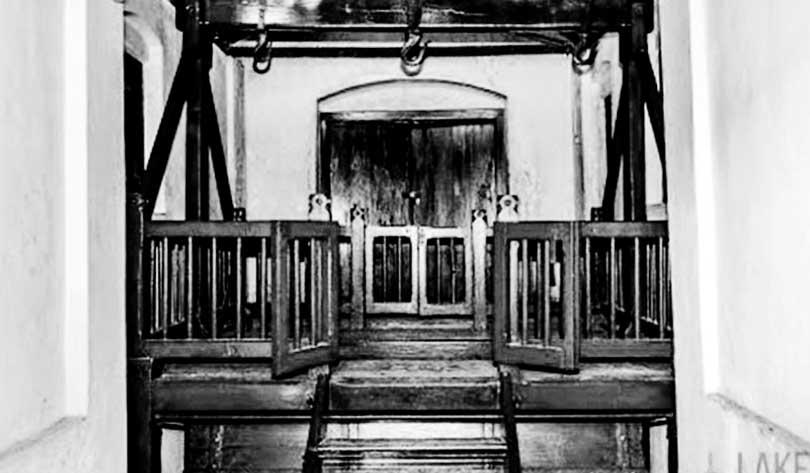27 Aug 2019 - {{hitsCtrl.values.hits}}

 As crime-rates keep falling in many parts of the world, prisons are being closed, with some of them being converted into hotels or tourist attractions.Violent crime rate has been falling in Sri Lanka too since the end of Eelam War IV in 2009. But that is not the reason for the government’s 2013 decision to abandon the iconic Bogambara Prison in Kandy. The Bogambara Prison was abandoned as part of the government’s plan to improve prison conditions by closing old and dilapidated ones located in the middle of towns and building modern ones outside the towns.
As crime-rates keep falling in many parts of the world, prisons are being closed, with some of them being converted into hotels or tourist attractions.Violent crime rate has been falling in Sri Lanka too since the end of Eelam War IV in 2009. But that is not the reason for the government’s 2013 decision to abandon the iconic Bogambara Prison in Kandy. The Bogambara Prison was abandoned as part of the government’s plan to improve prison conditions by closing old and dilapidated ones located in the middle of towns and building modern ones outside the towns.
The idea was to put the prime properties into good and productive use. It was under this scheme that the inmates of the Bogambara prison, built in 1876 were shifted to a new premises in Pallakele in 2013. Simultaneously, the then government led by President Mahinda Rajapaksa had a project to renovate colonial-era buildings and put them to contemporary commercial use. Colombo had many such building repaired and done up.
The Bogambara prison was handed over to President Rajapaksa in January 2014, and surely, his government would have undertaken rehabilitation, if he was not voted out of office in January 2015. The new government headed by Prime Minister Ranil Wickremesinghe had the same objective but had difficulty in meeting the expected cost which was US$ 7 to 10 million. In 2016, Minister Lakshman Kiriella suggested that the 382-cell Bogambara prison be converted into a luxury hotel. But this was vehemently opposed by the Mahanayakes of the Malwatte and Asgirya chapters of the Maha Sangha located in Kandy. It is reported that in a letter to President Maithripala Sirisena and Prime Minister Ranil Wickremesinghe, the Prelates suggested construction of a Kandyan cultural centre instead.
In the view of Dilip Susruta Samarasinghe, Director (Media) at the Board of Investment (BOI) which is trying to find foreign investors in the project, it will be difficult to convert the cells into hotel rooms. The walls are thick are difficult to break. The windows are tiny and right at the top. And most importantly, since it is a heritage site, the Archeology Department, which is a participant in the renovation project, will not allow any tampering with the structure, Samarasinghe explained.
However, following a global trend in which prisons are being turned into tourist destinations if they are of historical value, the government is pursuing the project with vigor. “Prisons, like other historical sites, provide a unique window into a country’s political history, views on crime and punishment, and laws governing freedom and human rights. Each year, millions of people trickle through the shadowy halls of decommissioned prisons around the world to learn their grim histories,” says writer Gulnaz Khan.
For example in the Texas Prison Museum in Huntsville, United States, the infamous American “electric chair” is displayed. In the Tuol Sleng prison cum torture chambers in the Cambodian capital city of Phnom Penh, one can see the tiny cells in which political prisoners were kept. The torture chambers and torture equipment are there for all to see. Bogambara Prison Project built in 1876 under the supervision of then Inspector General of Prisons N.R.Saunders, the Bogambara Prison was Sri Lanka’s second largest prison spanning 13 acres. Its 92,000-square foot main building has three floors. Given the vast amount of land in its premises, and its location bang in the middle of Kandy town, the land is very valuable and could be very productively used, Samarasinghe pointed out. The first phase of the project was completed and inaugurated by Premier Wickremesinghe last week. It saw the development of the prison’s external lands at a cost of approximately Rs.125 million (US$ 705, 930). The second stage entails the development of the buildings at an estimated cost of Rs.750 million (US$ 4.2 million).
According to reports, the second phase envisages the development of a cultural centre, an open air theatre, studios for traditional arts and crafts, a tourist information centre, multi recreational areas and a shopping complex. Most importantly, there will be a museum displaying the prison’s history. Since Kandy is a UNESCO World Heritage City, the Department of Archaeology is also involved in the designing of the project. The walls of the Bogambara Prison are said to look like the Bastille prison in Paris.
The structures were built with brick, lime, and wood, not concrete. Its floors are made of teak. Being short of funds, the government hopes to raise funds from overseas which is why it is a BOI project.

Gallows at Bogambara to execute three simulaneously
Historic Place
The Bogambara Prison is a historical place. It was one of the two prisons in which hangings took place till capital punishment was stopped, de facto, in 1975. Between 1876 - 1975, 534 prisoners were hanged at Bogambara. The prison was known for its gallows on which three persons could hang together.
Many Sri Lankan national leaders were interned in Bogambara. Among them were Dr. Colvin R. de Silva and Philip Gunawardene, N.M.Perera, Mavai Senathirajah and Tamil poet Kasi Ananthan. But some of these claims are disputed by H.G.Darmadasa, who was Superintendent at Bogambara Prison in the 1970s and had retired as Commissioner General Prisons. Darmadasa told Sunday Times that Colvin de Siva and Philip Gunawardene were kept in the New Kandy Remand Prison now used by the Sinha Regiment of the Army.
The claim that the celebrated 19th Century Sri Lankan Robin Hood, Saradiel, was held in Bogambara could also be challenged as Saradiel was hanged in 1864 long before Bogambara Prison was commissioned. But these do not detract from the historical importance of the Bogambara prison. The prison has always been a tourist attraction, albeit from the outside. It is located in the very heart of Kandy. Its Bastille like ramparts had never failed to attract.
Even before the establishment of the Bogambara Prison, executions and hangings were taking place in the Bogambara grounds.The entire family of Ehelpola, a noble who had rebelled against King Sri Wickramarajasinghe, was executed there in 1814. First the two sons were beheaded. Then their mother was made to pound their heads, and finally, the mother and her daughters were tied to stones and sunk in the Bogambara lake. People were out ranged but could do little. Ehelapola himself escaped as he was under British protection on the West coast.
After the British took over Kandy in 1815, they partially cleared the lake to build the Bogambara Prison. The gallows were shifted from the Hangman’s Hill to the newly built prison. It was on Hangman’s Hill that the Sri Lankan Robin Hood Saradiel was executed in 1864.
In 1818, chieftain Keppetipola, who had rebelled against the British in Uva, was beheaded on the Bogambara grounds. He wanted to be killed with one stroke, but the executioner failed. It was in the second attempt that the head was cut off. After his death, Keppetipola’s skull was taken to Britain and placed in the Phrenological Society of Edinburgh. Following the British withdrawal from Sri Lanka in 1948, Keppetipola was declared a national hero.
In 1954, his skull was brought to Sri Lanka and kept in the Keppetipola Memorial in Kandy. The Sri Lankan Robin Hood Saradiel was hanged on Hangman’s hill in 1864 which is now the Kandy Central Market. Prior to the shifting of the gallows into jails, beheading and hangings were done in public.
02 Jan 2025 21 minute ago
02 Jan 2025 41 minute ago
02 Jan 2025 1 hours ago
02 Jan 2025 3 hours ago
02 Jan 2025 3 hours ago